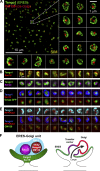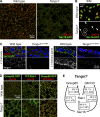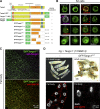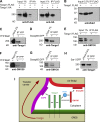Tango1 spatially organizes ER exit sites to control ER export
- PMID: 28280122
- PMCID: PMC5379956
- DOI: 10.1083/jcb.201611088
Tango1 spatially organizes ER exit sites to control ER export
Abstract
Exit of secretory cargo from the endoplasmic reticulum (ER) takes place at specialized domains called ER exit sites (ERESs). In mammals, loss of TANGO1 and other MIA/cTAGE (melanoma inhibitory activity/cutaneous T cell lymphoma-associated antigen) family proteins prevents ER exit of large cargoes such as collagen. Here, we show that Drosophila melanogaster Tango1, the only MIA/cTAGE family member in fruit flies, is a critical organizer of the ERES-Golgi interface. Tango1 rings hold COPII (coat protein II) carriers and Golgi in close proximity at their center. Loss of Tango1, present at ERESs in all tissues, reduces ERES size and causes ERES-Golgi uncoupling, which impairs secretion of not only collagen, but also all other cargoes we examined. Further supporting an organizing role of Tango1, its overexpression creates more and larger ERESs. Our results suggest that spatial coordination of ERES, carrier, and Golgi elements through Tango1's multiple interactions increases secretory capacity in Drosophila and allows secretion of large cargo.
© 2017 Liu et al.
Figures








Similar articles
-
Tango1 coordinates the formation of endoplasmic reticulum/Golgi docking sites to mediate secretory granule formation.J Biol Chem. 2019 Dec 20;294(51):19498-19510. doi: 10.1074/jbc.RA119.011063. Epub 2019 Nov 5. J Biol Chem. 2019. PMID: 31690624 Free PMC article.
-
New insights into protein secretion: TANGO1 runs rings around the COPII coat.J Cell Biol. 2017 Apr 3;216(4):859-861. doi: 10.1083/jcb.201701142. Epub 2017 Mar 14. J Cell Biol. 2017. PMID: 28292851 Free PMC article.
-
TANGO1 assembles into rings around COPII coats at ER exit sites.J Cell Biol. 2017 Apr 3;216(4):901-909. doi: 10.1083/jcb.201608080. Epub 2017 Mar 9. J Cell Biol. 2017. PMID: 28280121 Free PMC article.
-
Not just a cargo receptor for large cargoes; an emerging role of TANGO1 as an organizer of ER exit sites.J Biochem. 2019 Aug 1;166(2):115-119. doi: 10.1093/jb/mvz036. J Biochem. 2019. PMID: 31098622 Review.
-
Protein export at the ER: loading big collagens into COPII carriers.EMBO J. 2011 Aug 31;30(17):3475-80. doi: 10.1038/emboj.2011.255. EMBO J. 2011. PMID: 21878990 Free PMC article. Review.
Cited by
-
Dual function for Tango1 in secretion of bulky cargo and in ER-Golgi morphology.Proc Natl Acad Sci U S A. 2017 Nov 28;114(48):E10389-E10398. doi: 10.1073/pnas.1711408114. Epub 2017 Nov 14. Proc Natl Acad Sci U S A. 2017. PMID: 29138315 Free PMC article.
-
The conserved transmembrane protein TMEM-39 coordinates with COPII to promote collagen secretion and regulate ER stress response.PLoS Genet. 2021 Feb 1;17(2):e1009317. doi: 10.1371/journal.pgen.1009317. eCollection 2021 Feb. PLoS Genet. 2021. PMID: 33524011 Free PMC article.
-
Endoplasmic reticulum-to-Golgi trafficking of procollagen III via conventional vesicular and tubular carriers.Mol Biol Cell. 2022 Mar 1;33(3):ar21. doi: 10.1091/mbc.E21-07-0372. Epub 2022 Jan 19. Mol Biol Cell. 2022. PMID: 35044867 Free PMC article.
-
Protein retention in the endoplasmic reticulum rescues Aβ toxicity in Drosophila.Neurobiol Aging. 2023 Dec;132:154-174. doi: 10.1016/j.neurobiolaging.2023.09.008. Epub 2023 Sep 21. Neurobiol Aging. 2023. PMID: 37837732 Free PMC article.
-
Unfolded protein responses: Dynamic machinery in wound healing.Pharmacol Ther. 2025 Mar;267:108798. doi: 10.1016/j.pharmthera.2025.108798. Epub 2025 Jan 17. Pharmacol Ther. 2025. PMID: 39826569 Review.
References
Publication types
MeSH terms
Substances
LinkOut - more resources
Full Text Sources
Other Literature Sources
Molecular Biology Databases
Research Materials

